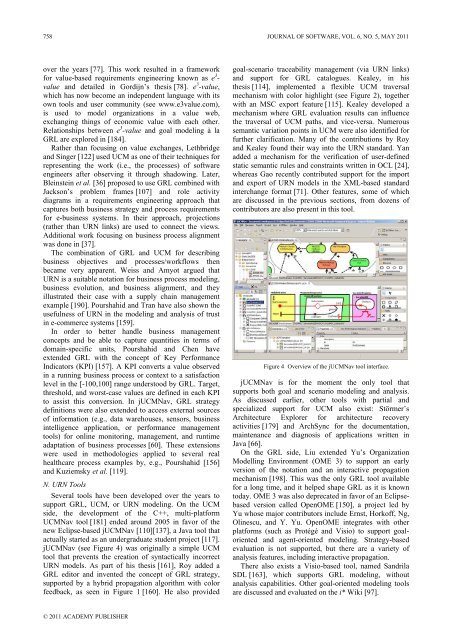Journal of Software - Academy Publisher
Journal of Software - Academy Publisher
Journal of Software - Academy Publisher
You also want an ePaper? Increase the reach of your titles
YUMPU automatically turns print PDFs into web optimized ePapers that Google loves.
758 JOURNAL OF SOFTWARE, VOL. 6, NO. 5, MAY 2011<br />
over the years [77]. This work resulted in a framework<br />
for value-based requirements engineering known as e 3 -<br />
value and detailed in Gordijn’s thesis [78]. e 3 -value,<br />
which has now become an independent language with its<br />
own tools and user community (see www.e3value.com),<br />
is used to model organizations in a value web,<br />
exchanging things <strong>of</strong> economic value with each other.<br />
Relationships between e 3 -value and goal modeling à la<br />
GRL are explored in [184].<br />
Rather than focusing on value exchanges, Lethbridge<br />
and Singer [122] used UCM as one <strong>of</strong> their techniques for<br />
representing the work (i.e., the processes) <strong>of</strong> s<strong>of</strong>tware<br />
engineers after observing it through shadowing. Later,<br />
Bleinstein et al. [36] proposed to use GRL combined with<br />
Jackson’s problem frames [107] and role activity<br />
diagrams in a requirements engineering approach that<br />
captures both business strategy and process requirements<br />
for e-business systems. In their approach, projections<br />
(rather than URN links) are used to connect the views.<br />
Additional work focusing on business process alignment<br />
was done in [37].<br />
The combination <strong>of</strong> GRL and UCM for describing<br />
business objectives and processes/workflows then<br />
became very apparent. Weiss and Amyot argued that<br />
URN is a suitable notation for business process modeling,<br />
business evolution, and business alignment, and they<br />
illustrated their case with a supply chain management<br />
example [190]. Pourshahid and Tran have also shown the<br />
usefulness <strong>of</strong> URN in the modeling and analysis <strong>of</strong> trust<br />
in e-commerce systems [159].<br />
In order to better handle business management<br />
concepts and be able to capture quantities in terms <strong>of</strong><br />
domain-specific units, Pourshahid and Chen have<br />
extended GRL with the concept <strong>of</strong> Key Performance<br />
Indicators (KPI) [157]. A KPI converts a value observed<br />
in a running business process or context to a satisfaction<br />
level in the [-100,100] range understood by GRL. Target,<br />
threshold, and worst-case values are defined in each KPI<br />
to assist this conversion. In jUCMNav, GRL strategy<br />
definitions were also extended to access external sources<br />
<strong>of</strong> information (e.g., data warehouses, sensors, business<br />
intelligence application, or performance management<br />
tools) for online monitoring, management, and runtime<br />
adaptation <strong>of</strong> business processes [60]. These extensions<br />
were used in methodologies applied to several real<br />
healthcare process examples by, e.g., Pourshahid [156]<br />
and Kuziemsky et al. [119].<br />
N. URN Tools<br />
Several tools have been developed over the years to<br />
support GRL, UCM, or URN modeling. On the UCM<br />
side, the development <strong>of</strong> the C++, multi-platform<br />
UCMNav tool [181] ended around 2005 in favor <strong>of</strong> the<br />
new Eclipse-based jUCMNav [110][137], a Java tool that<br />
actually started as an undergraduate student project [117].<br />
jUCMNav (see Figure 4) was originally a simple UCM<br />
tool that prevents the creation <strong>of</strong> syntactically incorrect<br />
URN models. As part <strong>of</strong> his thesis [161], Roy added a<br />
GRL editor and invented the concept <strong>of</strong> GRL strategy,<br />
supported by a hybrid propagation algorithm with color<br />
feedback, as seen in Figure 1 [160]. He also provided<br />
© 2011 ACADEMY PUBLISHER<br />
goal-scenario traceability management (via URN links)<br />
and support for GRL catalogues. Kealey, in his<br />
thesis [114], implemented a flexible UCM traversal<br />
mechanism with color highlight (see Figure 2), together<br />
with an MSC export feature [115]. Kealey developed a<br />
mechanism where GRL evaluation results can influence<br />
the traversal <strong>of</strong> UCM paths, and vice-versa. Numerous<br />
semantic variation points in UCM were also identified for<br />
further clarification. Many <strong>of</strong> the contributions by Roy<br />
and Kealey found their way into the URN standard. Yan<br />
added a mechanism for the verification <strong>of</strong> user-defined<br />
static semantic rules and constraints written in OCL [24],<br />
whereas Gao recently contributed support for the import<br />
and export <strong>of</strong> URN models in the XML-based standard<br />
interchange format [71]. Other features, some <strong>of</strong> which<br />
are discussed in the previous sections, from dozens <strong>of</strong><br />
contributors are also present in this tool.<br />
Figure 4 Overview <strong>of</strong> the jUCMNav tool interface.<br />
jUCMNav is for the moment the only tool that<br />
supports both goal and scenario modeling and analysis.<br />
As discussed earlier, other tools with partial and<br />
specialized support for UCM also exist: Störmer’s<br />
Architecture Explorer for architecture recovery<br />
activities [179] and ArchSync for the documentation,<br />
maintenance and diagnosis <strong>of</strong> applications written in<br />
Java [66].<br />
On the GRL side, Liu extended Yu’s Organization<br />
Modelling Environment (OME 3) to support an early<br />
version <strong>of</strong> the notation and an interactive propagation<br />
mechanism [198]. This was the only GRL tool available<br />
for a long time, and it helped shape GRL as it is known<br />
today. OME 3 was also deprecated in favor <strong>of</strong> an Eclipsebased<br />
version called OpenOME [150], a project led by<br />
Yu whose major contributors include Ernst, Hork<strong>of</strong>f, Ng,<br />
Olinescu, and Y. Yu. OpenOME integrates with other<br />
platforms (such as Protégé and Visio) to support goaloriented<br />
and agent-oriented modeling. Strategy-based<br />
evaluation is not supported, but there are a variety <strong>of</strong><br />
analysis features, including interactive propagation.<br />
There also exists a Visio-based tool, named Sandrila<br />
SDL [163], which supports GRL modeling, without<br />
analysis capabilities. Other goal-oriented modeling tools<br />
are discussed and evaluated on the i* Wiki [97].

















